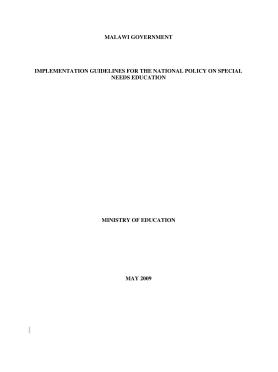Implementation Guidelines for the National Policy on Special Needs Education - Malawi 2009
Implementation Guidelines for the National Policy on Special Needs Education - Malawi 2009
Special Needs Education in Malawi began in the early 1950’s under the guidance of faith-based organisations. These were the missionaries of the Dutch Reformed Church, South African Evangelical Church and the Roman Catholic Church. The Dutch Reformed Church established a school for learners with visual impairment at Chilanga in Kasungu in 1950. In the same year, the South African Evangelical Church opened Lulwe School for learners with visual impairment in Nsanje. The Roman Catholic Church, through the Brothers of Immaculate Conception, established Mary View School for the Deaf in Chiradzulu in 1968. In the same year, the Roman Catholic Church identified a need for specialist teachers for these schools hence opened a Specialist Teacher Training College at Montfort College campus. The Malawi Government officially began to provide funding for Special Needs Education programmes in 1967.
Malawi is a signatory to a number of universal agreements that advocate for the provision of adequate education opportunities for learners with special educational needs. From these agreements, Malawi has developed more comprehensive strategies to better respond to the educational needs of learners with special educational needs. The national special needs education policy provides a framework for Special Needs Education in Malawi . The implementation guidelines for the national policy on Special Needs Education therefore, provide a mechanism for the effective and standardized implementation of National Policy on Special Needs Education.
The national policy focuses on the three priority areas as stipulated in the National Educational Sector Plan (NESP). The priorities encompass components of Special Needs Education which include: early identification, assessment and intervention; advocacy, care and support; management, planning and financing; access, quality, equity and relevance. Each of these components has strategies to ensure their effective implementation.
The formulation of these implementation guidelines resulted from consultative meetings with various stakeholders, and a review of a cross-section of literature with specific consideration to the relevant educational targets set in the Education For All (EFA), Millennium Development Goals (MDG), United Nations Standard Rules for Equalization of Opportunity for Persons with Disabilities, Salamanca Statement on Special Needs Education, Malawi Growth and Development Strategy (MGDS), Policy Investment Framework (PIF), and the National Education Sector Plan

